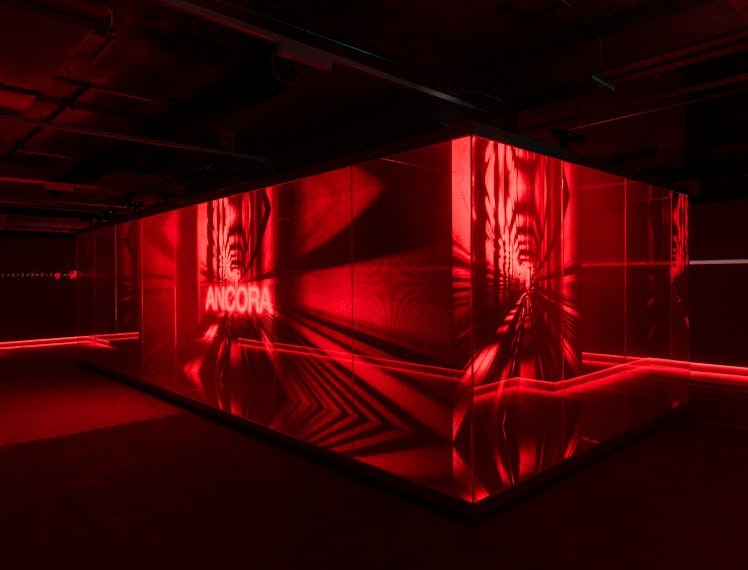Gucci Gets Its Story Straight
At an immersive exhibition in London, a house in the process of building its future invites people to explore its past.

While Taylor Swift’s Eras Tour may not be making its way to London until summer 2024, another blockbuster showcase that weaves together the various iterations of a pop culture icon just landed in the British capital.
Gucci Cosmos, on view at 180 Studios in London through the end of December, is a crash course in the Italian house’s visuals, values and visions of the future—and a reminder to anyone who considers Gucci’s evolving aesthetic over the years as too disparate to reconcile that they would benefit from taking a closer look.
The exhibition, designed by the British artist Es Devlin and curated by the Italian fashion theorist and critic Maria Luisa Frisa, opens at a pivotal moment, on the heels of creative director Sabato De Sarno’s debut collection. As the brand figures out what it wants its future to look like, now seems like the perfect time to remind people of where it’s been. But don’t call it a retrospective: “We didn’t use that because it’s not about going backwards, it’s a continual story,” Frisa said, speaking to a group gathered on the day of the opening. “An emotional voyage.”
“I wanted to get to the core of the mythology at the heart of the house,” added Devlin. “Why has it spread with such joy and ferocity around the world?” Her creative process started at the Gucci archive in Florence, which she described as “like entering a maze of multiple imaginations through time,” noting that objects by different creative directors carried different energies. “My background in theater allows me to understand that objects can speak to you,” she said. “I thought, How can I allow these objects to be protagonists, so that everyone can hear them speak?”
After passing through a recreation of the Savoy Hotel elevator in which a young Guccio Gucci once served as a porter and lift operator, inspiring him to get into the luggage game, visitors pass through a series of spaces that tell the story of the house, from its founding in 1921 to today, and ties together the visual threads woven by previous creative directors Tom Ford, Frida Giannini and Alessandro Michele.
In one room, archival luggage spins slowly on the world’s chicest baggage claim, another honors the house’s equestrian legacy that inspired the iconic horse bit hardware. An “Eden” room filled with whitewashed, larger than life plant and insect life reminds visitors that the Flora motif most contemporary customers would associate with the Michele era actually harkens back to 1966, when Rodolfo Gucci commissioned an illustrator to design a botanical scarf for Princess Grace of Monaco. The bright florals also appeared as a leitmotif in a 1981 collection and has tugged at the imaginations of every designer who’s been at the helm since. An interactive corridor, inspired by Devlin’s visits to the archive, invites visitors to pull open glowing drawers that reveal old ad campaigns, illustrations and look books—a deft way to pack in lots of material while appealing to our voyeuristic impulses.
Towards the end of the progression, a carousel featuring 25 mannequins wearing runway looks from the pre-creative-director era to today rotates behind a gauzy screen, inviting close inspection of a white jersey cutout gown by Ford, a flapper-inspired dress by Giannini, and several of Michele’s bedazzled, trompe l’oeil extravagances. A standout coat from De Sarno’s first runway show, featuring a cascade of crystal-embellished fringe, feels both utterly wearable and totally dazzling when seen at arms length—sharp, perfectly tailored wool caught in a surrealist downpour of beads.
This installation makes the best case for the show’s central narrative. The contrasting curation of objects, to borrow Devlin’s metaphor, may be speaking different languages, but still manage to have a coherent conversation with one other. The looks, when displayed in a clear line, have a shared vocabulary of craft, high drama, sex appeal and playfulness that flows from one era to the next.
The final room in the exhibition is dubbed “Ancora” (Italian for “still”), the word that’s been chosen to represent the brand’s new era under De Sarno. Frisa describes the deep red space filled with audio snippets and a black-and-white video montage as “a way to see inside the head of a creative person,” but the experience feels abstract, difficult to grasp beyond a general mood, a collection of references.
A visit to the Gucci store on nearby New Bond Street is perhaps a better way to understand what the next chapter holds. There’s nary a Michele-esque fringe, flounce or fauna motif to be found. Instead, the walls are white, the upholstery sleek and muted—it has the hushed neutrality of a blue chip art gallery, each bag and shoe perfectly and invitingly lit. In a wood paneled space towards the back, luggage and accessories from the archives peer out from behind glass, a reminder of the rich heritage that ties the whole story together.
This article was originally published on